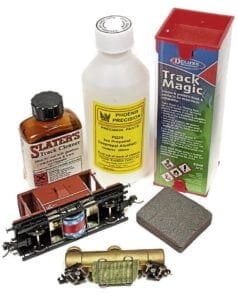Keeping track clean is one job we all have to do to keep the trains running well, and there are several effective ways of going about it, explains Nigel Burkin.
One chore that faces all modellers in almost every scale and gauge – particularly at the smaller end of the spectrum – is track cleaning.
It can come as a bit of a surprise to new modellers when their lovely new trains stop working properly, and by now those who entered this wonderful hobby of ours for the first time with a train set or other equipment this past Christmas might already have encountered the problem of dirty track and locomotive wheels.

Do not despair that your new models now stall and show signs of running poorly, for there will be nothing mechanically wrong with them other than dirty rails and/or wheels, but wheel cleaning is a subject for another day.
Cleaning the track of a layout or temporary set-up will resolve a lot of the issues you will encounter with poor running, and should form part of your layout maintenance routine.
It should include dusting or vacuuming the track itself to remove dust and hairs, together with treating the rails themselves with a cleaner of some description.
Cleaning the rails is a science and a major branch of the hobby itself, judging by the wide variety of products and devices available for track cleaning.
Where does dirt come from?

New locomotive models should work well straight from the box for the first few operating sessions, for the track and locomotive wheels will be in a clean condition when purchased. Over time, though, particularly if the train set is developed as a permanent layout, dust (skin cells), hairs and grime eventually settle on the top of the rails.
For the full article and to view more images, see the March 2019 edition of Modelling – available now!
For a complete list of stockists and how to get your copy, visit: www.railwaymagazinemodelling.co.uk/distributors
Advert



